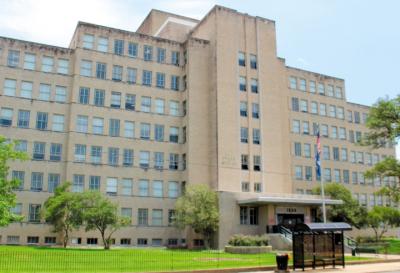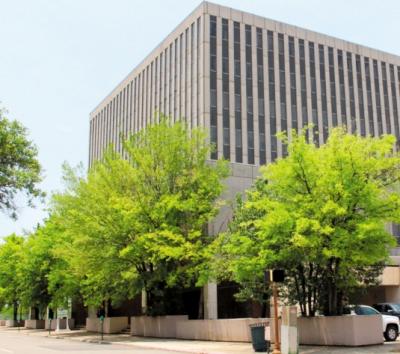Moving Downtown

Consolidating state offices in one facility
Aflurry of movement in Baton Rouge regarding the move of the State Office Building from Fairfield Avenue to 500 Fannin Street in downtown Shreveport.
On Wednesday, the Louisiana Architect Selection Board chose Shreveport architectural, environmental and consulting firm Newman Marchive Inc. to handle the demolition and abatement phase of the $70M revamp of the building and adjacent parking garage.
Newman and his team will be responsible for stripping the existing building of all exteriors, all interior systems, all asbestos and other hazardous materials, demolition of the current parking garage and cleaning and clearing of the parking garage foundation.
The Architect Selection Board also narrowed down the list of firms that have submitted proposals to manage the design and build phase of the project from nine to four. The shortlisted firms are:
 • Holly and Smith Architects (based in Hammond, La.)
• Holly and Smith Architects (based in Hammond, La.)
• Coe/Arquitectonica (Shreveport and Miami-based firms)
• Coleman Partners/Eskew Dumez Ripple Architects (Baton Rouge and New Orleans-based firms)
• Prevot/Grace-Hebert Architects (Shreveport and Baton Rouge-based firms)
In two weeks, each team will make an oral presentation to the board before a final selection.
As with many things dealing with government, the wheels turn slowly. This activity started more than 25 years ago, when serious discussion of moving the state office building downtown started. Here is a short look at a portion of an interesting timeline:
• 1994 - The lease on 500 Fannin, the former Joe D. Waggonner (JDW) Federal Building, ends.
• 1997 - Downtown Development Authority (DDA) and Downtown Shreveport Development Corp. (DSDC) meet with the NWLA legislative delegation to start the process of determining if the state offices can be moved downtown. Freshman legislator Cedric Glover is a part of these initial meetings.
• 1997 - DDA sends a letter to Roger Magendie, director of administration facility planning and control, providing information on the JDW building. A tour, floor plans and estimated costs of asbestos remediation follow.
• 2000 - State officials visit downtown and tour downtown properties, including JDW.
• 2000 - DSDC signs option to purchase JDW for $1M.
• 2001 - DSDC3 is created with the goal of relocating governmental entities, specifically the state office building, to downtown Shreveport.
• 2002 - Mark Drennen, commissioner of administration under Governor Mike Foster, alerts DDA that the state “does not see benefit” at this time of moving agencies to downtown.
• 2004 - DDA resumes conversation with the state about a possible move to downtown.
• 2008 - Interest is renewed. DDA meets with Billy Wilson, the director of the Office of State Buildings, about a possible move.
 As the years passed, we saw that interest in moving the state office building downtown ebbed, flowed, waned or waxed depending on the fiscal situation of the state, who sat in the governor’s seat and actions taken here at home. A promising turn came in 2012 when the state conducted a feasibility study for consolidation of state agencies and office facilities in the Shreveport area. The Jones, Lang, LaSalle report once and for all settled, many believed, both the
feasibility and good sense of such a move. Baton Rouge, in particular,
had seen a huge change in their downtown due to state investment. State improvements incentivized private investors to spend money,
build and rehabilitate. Representative Cedric Glover saw the profound
changes firsthand between his first and second stints at the statehouse.
As the years passed, we saw that interest in moving the state office building downtown ebbed, flowed, waned or waxed depending on the fiscal situation of the state, who sat in the governor’s seat and actions taken here at home. A promising turn came in 2012 when the state conducted a feasibility study for consolidation of state agencies and office facilities in the Shreveport area. The Jones, Lang, LaSalle report once and for all settled, many believed, both the
feasibility and good sense of such a move. Baton Rouge, in particular,
had seen a huge change in their downtown due to state investment. State improvements incentivized private investors to spend money,
build and rehabilitate. Representative Cedric Glover saw the profound
changes firsthand between his first and second stints at the statehouse.
No good idea can move forward without consensus and support. Unwavering support came in the form of one-time Shreveport City Councilman (1990- 96), State Representative (1996-2006) and Mayor (2006-2014) Cedric Glover, who returned to the Louisiana Legislature in 2016-present. For the duration of his terms holding various elective offices, Glover stressed the importance of the state office move downtown. When the JDW building became available in 2013, he knew that the state not only had the means, it finally had the perfect location. Roughly a year and a half ago, he found an ally in this game of high-stakes negotiating in State Senator Robert Mills, who saw the fiscal common sense of the repurposing of the former Waggonner building and the move as a whole as a benefit to northwest Louisiana.
Though the plan made sense and saved the state a significant amount of money, some did not support it.
“It was a strange deal,” Mills said. “There were a lot of battles behind the scene.”
“It’s like my grandfather used to say,” says Glover. “It takes a genius to build a barn, but a jackass can knock it down.”
It had gotten to the point for Glover and Mills that doing nothing on the state building in Shreveport was not an option, and they would not back down.
It is a classic tale of hard work and never-say-die effort. “To expect to be successful at something, you have to be transparent,” says Glover, “and be relentless.”
That
could be the moral of this long story, or its headline, “Relentlessness
Wins.” We are thankful for all those who refused to relent, and
continued, in the face of adversity, to continue to push a good idea
forward.
History: One Year Ago Is the state building downtown bound?
Sep 23, 2021 | Liz Swaine | In 2012, the state of Louisiana hired a commercial real estate/property investment company named Jones Lang LaSalle to research the answer to a question that was becoming more and more important – the feasibility of consolidating state office buildings in Shreveport into one facility in downtown Shreveport.
It was a question that needed to be asked because the answer seemed like it would be a no-brainer. The state could continue to try to fit a round peg into a square hole, putting taxpayer dollars into a building on Fairfield Avenue that would never completely fit their needs and could continue to pay for leased properties all over the city and deal with the logistical issues of the state agencies housed there, or they could see if there was a better way.
 The
Jones Lang LaSalle report considered the state’s options: to stay put
at the Mary Allen Building on Fairfield, to build and own a 72,000
-square-foot building, to build and own a 149,000-squarefoot building,
or to lease only. The report did what reports do – it compiled a lot of
data, looked at the scenarios for each option and presented the
findings, which showed, compellingly, why spending more money on the
Allen building or leasing existing office space were the worst of the
options presented. Building or building out new space was clearly the
option that met or exceeded all the categories.
The
Jones Lang LaSalle report considered the state’s options: to stay put
at the Mary Allen Building on Fairfield, to build and own a 72,000
-square-foot building, to build and own a 149,000-squarefoot building,
or to lease only. The report did what reports do – it compiled a lot of
data, looked at the scenarios for each option and presented the
findings, which showed, compellingly, why spending more money on the
Allen building or leasing existing office space were the worst of the
options presented. Building or building out new space was clearly the
option that met or exceeded all the categories.
In the nine years since the report was completed, Baton Rouge has seen a flurry of state office construction in their downtown, which has helped lead to renewed interest by private developers in other buildings and increased the number of building rehabs and apartment conversions. The state also partnered with the city and parish to build an eight-story office building for IBM that also houses upscale apartments. The website for 525 Lafayette touts it as “downtown’s most exciting address.’’
In the nine years in Shreveport since the Jones Lang LaSalle report, there has been no downtown construction by the state and no real sustained movement on a state project downtown until now. In 1996, Cedric Glover first went to Baton Rouge as a state representative, serving under then-Governor Mike Foster. Glover spent a lot of time in downtown Baton Rouge, cooling his heels until the regularly scheduled 4 p.m. start for the Legislature. He remembers trying to find something, anything, to do to while away the hours.
“I’m trying to put it nicely,” he tells me. “There just wasn’t a lot going on in downtown Baton Rouge.” Over the years, Glover was a firsthand witness to what well-planned state investment in downtown offices could do. He knew that it could help his downtown Shreveport district and the city as a whole. “Moving the state office to downtown Shreveport just makes sense. It did then, and it does now.” When the 152,000- square-foot former federal building at 500 Fannin Street, just across from the state-owned Second Circuit Court of Appeal, one block from Government Plaza and two blocks from the Caddo Courthouse, became available, it made even more sense.
The former Joe D. Waggonner Federal Building also made sense to the state Division of Administration and Office of Facility Planning. They saw added value in the building’s “good bones,” the great location, the attached parking garage. The numbers show that it can be a blank slate rehab that will work in a way the Mary Allen Building never will, no matter how much money is invested there.
“The wins are so numerous,” says Glover. “It (state ownership and rehab) eliminates the blight of the Waggonner building, which is a gift from heaven. The state benefits from the proximity to the Second Circuit Court, and downtown benefits from a building filled with people and additional foot traffic in an area that needs it. Highland benefits by the state releasing a building that could have a higher and better use, that could bring more vibrancy to that neighborhood and infuse additional population there.”
Will Hurricane Ida and south Louisiana’s struggle to rebuild kill the opportunity? “It should not,” says Glover. “From what I am being told at this point, we should be able to move forward.”
“We’ve been dealing with this for years. The iron is as hot as it’s ever been. We don’t need to fail to strike.” Commissioner of Administration Jay Dardenne has the goal of a decision in 90 days. We hope that decision will be to consolidate state offices and move them downtown.
Liz Swaine is the executive director of the Downtown Development Authority. She can be reached at liz@downtownshreveport.com
